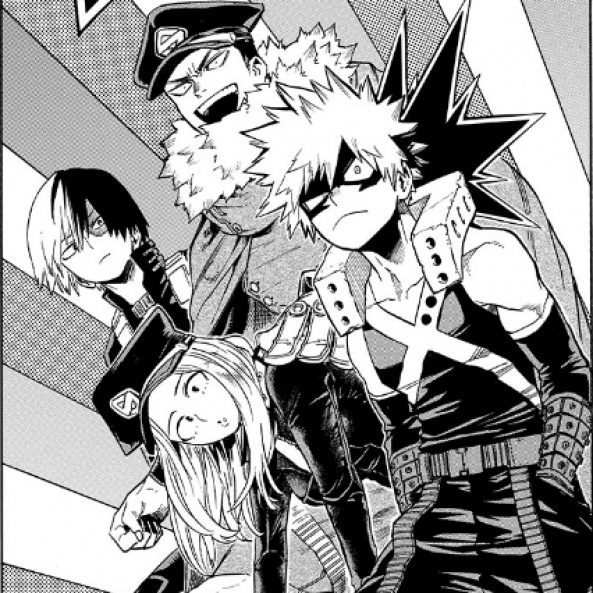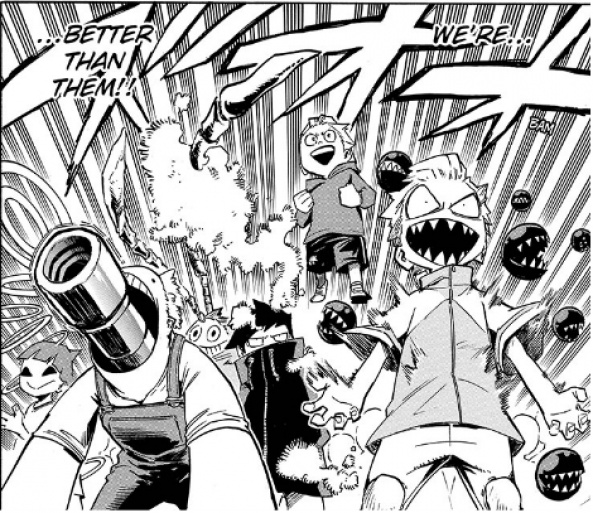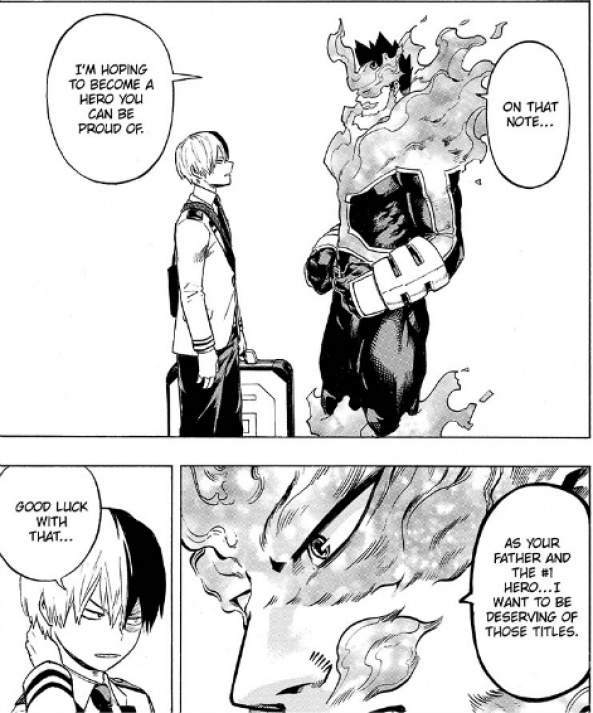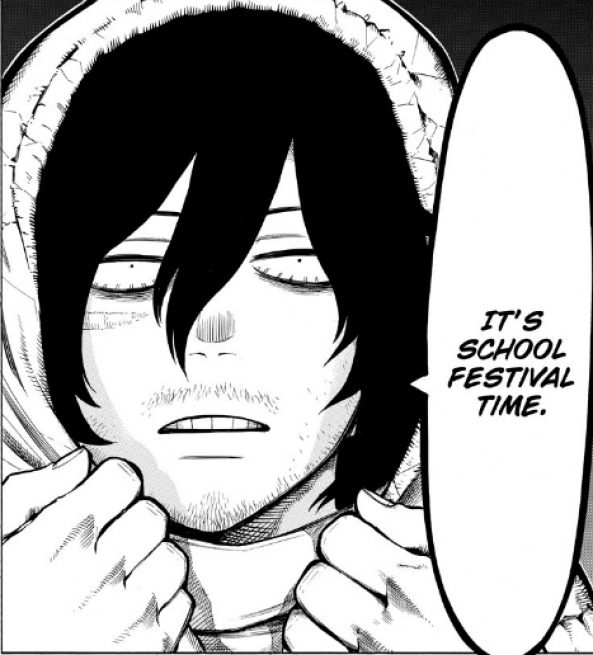In stark contrast to last month’s two chapters, this most recent set of “My Hero Academia” content consists of five chapters, with which I will look to discuss in detail. While none of these chapters was particularly action-packed, I would be doing mangaka Kōhei Horikoshi’s fantastic writing a disservice if I didn’t highlight the plethora of development that this material both initiates in some characters, and expands upon in others, as part of this analysis.
These five chapters can actually be split roughly down the middle, in regard to the group of characters they are drawing attention to. And yet all the same, Horikoshi manages to craft engaging scenarios and dialogue throughout, which left me consistently satisfied with the progression of the narrative. The first half of this month’s batch looks to continue the solid foundation put in place by last month’s work, as we follow the exploits of the Provisional License Trainees, which runs concurrent to a particularly prevalent conversation that is being had by Endeavor and All Might.

On the students’ side of things in Chapter 165 (titled ‘Win Those Kids’ Hearts’), we see the four trainees take turns in trying to complete their assignment, by attempting to connect with the hearts of an unruly group of elementary school children. Each character approaches this somewhat unusual scenario with their very unique approach, and the natural way in which this hilarious scene plays out is testament to Horikoshi’s prior establishing of specific character traits. There are also smaller character interactions between these four that help to cement them as both a unit, and also allow for a sense of realism, considering their actual ages. For example, Camie openly and happily mocks Bakugo’s aggressive exterior, Bakugo holds back from berating Todoroki’s different viewpoint after remembering a conversation he overheard at the Sports Festival, and Inasa tries to console Todoroki as he is intent on becoming friends with his elemental rival no matter what.
Beyond these enjoyable interactions though, Horikoshi is also sure to include subtle elements of world-building into this scenario. The first of these comes from the Masegaki teacher, who notes that due to the unique effects of some quirks on a child’s development, sound emotional support is provided via counselling. Looking beyond this, it is not unreasonable to assume that some villains behave the way they do because their hearts were either closed off as a child so the counselling was insufficient, or they simply did not receive the counselling to begin with. After all, there is a strong possibility that a lack of counselling affected Tomura Shigaraki’s own mentality, hence the heroes referring to him as a man-child after the USJ attack. In the current situation, the importance of youth quirk counselling and the potential for mayhem if its effectiveness is lacking, is then showcased by the willingness of the young kids to use their quirks on relative strangers. So while the task the four young heroes are charged with may seem relatively inconsequential at first glance, becoming heroes who are capable of inspiring the next generation into opening their hearts and wanting positive futures for themselves, thereby warding some away from potentially villainous lifestyles, is actually incredibly necessary.

Chapter 166 (titled ‘Proud of the License Trainees’) also manages to communicate world-building components to its audience, but in a somewhat less subtle way than Chapter 165’s material. However, given the relative importance of this particular development, it’s understandable that Horikoshi would want to signpost it heavily. After all, providing a clear-cut reason as to why each new generation’s quirks are likely more powerful than the last, is incredibly important in establishing logical power scaling for the series. In fact, the explanations given here do more than lay a rational foundation of understanding for the series’ future. They even manage to make better sense of past encounters of the series, when looking back and considering that the youthful Class 1-A has already managed to compete with both heroes and villains who are many years their senior.
And even beyond this we are introduced to a concept that, while it may very well seem to be forewarning us of a potential problem down the line for this universe, it is actually giving context to a character that has already appeared. For with the ‘Quirk Singularity Doomsday Theory’, a belief that there will come a day when quirks have evolved to the extent where individuals can no longer control them, we may have already reached that with the advent of Eri and her unbelievably dangerous ‘Rewind’ quirk. This looming threat of Eri is teased in the other chapters of this month’s batch also, but for now, I wish to continue with Chapter 166.
Continued below
While the beginning communicates important information to the reader that should not be missed, the final ten pages of this chapter are also deserving of recognition for many reasons. It may be true that the comical reaction faces and humour-filled dialogue persist throughout this mini-story arc, but during these ten pages, we are also treated to new quirks (like Camie’s Glamour), especially stunning art and unbelievably poignant dialogue. These steps taken by Horikoshi all manage to pull together, and perhaps best demonstrate his incredible ability to write compelling situations that aren’t necessarily rooted in danger.
A note I’d like to make about the exceptional dialogue found here, before moving on to the next chapter, is that both of the striking conversations are only truly impactful as a result of prior character development. The first can be seen with Bakugo, whose true outlook has certainly changed following his recent conflict with Deku, as he chooses to impart wisdom that clearly comes from his own experience and shortcomings. The other is a resolution to the question Endeavor posed to All Might at the end of last month, wherein All Might simply refers the new top hero to the progress his own son has made, which is character development that Horikoshi has been portraying for over 100 chapters at this point. Presenting continuous payoffs from established character development only serves to heighten the readers’ excitement for any other instances of characterisation and elaboration we may see, as the impact of such things may be extensive and meaningful, as opposed to other series that may instead rely on shallow and ultimately irrelevant characterisation work.

The impactful dialogue does not stop there, however. As part of the next chapter (aptly titled ‘#1 Hero’s Starting Line’), following the completion of the assignment set by Gang Orca, the License Trainees run into a number of important people outside of the venue. While the mention of shared information between U.A. and Shiketsu is important, as is the possibility of joint practical training between the two institutions, the highlight of this scene is undoubtedly a reunion between the two Todorokis. While Shoto is understandably wary of his father, given their history, it is undeniable that Endeavor has been changed by recent events. Horikoshi manages to depict a realistic scene here, with Endeavor making a genuine step in the right direction as to correcting his own attitude toward a multitude of things, which is then acknowledged by the previously sceptical Inasa in a semi-comedic fashion, without compromising Shoto’s comprehensibly hesitant demeanour.

The second half of this month’s batch places the focus back on the classroom, which allows for further exploration of Class 1-A’s general dynamic, along with a deeper look into specific members of the class who have recently been out of the limelight. The transition from the License Trainees back to the school environment is aided by a passage of time, which shows that the story now finds itself in October. This time of year for high school students in Japan is synonymous with School Festivals, and so prior to reading the most recent chapter I indeed wondered if that would also be the case in the “My Hero Academia” universe, which of course we now know it is. The narration that accompanies the brief time skip is not inconsequential, however. We are told that Nighteye’s funeral has taken place, the work studies have been suspended for the foreseeable future, and Centipeder has taken over the Nighteye agency. We also get some more information pertaining to Eri, which I alluded to earlier in this analysis. It’ll be interesting to see where Horikoshi takes her character moving forward, and how she indeed relates to the supposed ‘Quirk Singularity Doomsday Theory’ that Shishikura informed us of.
Following that though we indeed transition back into the classroom, where hilarity ensues. Ectoplasm is revealed to be the kids’ mathematics teacher, and Deku is shown to be working as hard as ever, following the trend that began with his defeat to Bakugo. What remains of the chapter though, along with the following one (titled ‘The Strange Tale of Aoyama’), is certainly focused on the somewhat eccentric Francophile. While at first his behaviour may seem sketchy, and perhaps related to the potential traitor that exists within U.A., it is made clear by the end of Chapter 168 that Aoyama is simply an awkward teen. After an initial period of distancing himself from the rest of the class, he begins to relate with Deku after realising that both of their quirks don’t fully suit their bodies. While he may not completely grasp the reality of Deku’s situation with One For All, Aoyama’s own history with his support belt is reason enough for him to wish to finally close the gap between him and a classmate, thereby making his first true friend at the school. While this development may seem minor, given Horikoshi’s track record, I believe that this newly established friendship will have narrative significance in the future, much like Bakugo and Kirishima’s friendship ended up having.
Continued belowOutside of the blatant Aoyama focus in Chapter 168, there are also a number of smaller details I wish to highlight, as they too may come back with a purpose later down the line. The first is the news that Edge Shot, the now #4 Hero, is teaming up with both Mt. Lady and Kamui Woods. The fact that such a high profile hero feels it is necessary to band together with two talented up-and-comers, who played their part at Kamino, demonstrates that there is a very real threat of villain uprisings in Japan following All Might’s retirement. The changing environment within which the U.A. students reside is sure to create some interesting challenges in the future, as they work towards becoming pro heroes themselves. As such, it only makes sense that they continue to train hard, and we are shown this also in this chapter. Nice details include Mina’s recognition of Kirishima’s ‘Unbreakable’ form, Kirishima’s own recognition that Bakugo, Deku and Sato are probably the strongest students in Class 1-A, and Bakugo’s continued rapport with Deku regarding their joint drive to improve. A final detail, which may end up having more clout than any of the others, is Aoyama’s engraving of the French proverb ‘still waters run deep.’ Given Aoyama’s observant nature, having realised Uraraka’s feelings for Deku before anyone else, it could be the case that he has witnessed something unsettling about one of their quieter classmates. This could mean very little in the grand scheme of things, but until proven otherwise, this could well be something that is worth keeping an eye out for.

The final chapter of this batch (titled ‘School Festival’), is very much rooted in slice of life antics, and is used as a vehicle for character development. While the primary work here is done for Jiro, along with her friendships with both Kaminari and Koda, there are little details reserved for other members of the class. Ashido’s dancing hobby appears once again, after having been seen during Kirishima’s middle school flashback, and leads to both Deku and Aoyama getting involved. This Aoyama participation stems directly from the development he received in Chapter 168, so it’s nice to see an immediate minor payoff there. Regarding Deku though, it’s interesting to see he notes that dancing allows for an impressive command over one’s whole body, so while his learning to dance may seem trivial initially, it may indeed still be linked to Deku’s finer honing of One For All moving forward.
It is also fascinating to see just how well Horikoshi has characterised Class 1-A as a whole, since their introduction, as is shown with a specific instance with this chapter. While attempting to decide on an exhibition that the class can put on for the School Festival, twenty possibilities are written on the board. Credit really has to be given to Horikoshi here, as previous declarations of interests by the characters allow the reader to easily decipher just who suggested what.

In the end though, with the unlikely aid of Todoroki, who too has grown from his most recent experience, the class decides on a dance club with live music. I’m thoroughly excited to see how this all unfolds, and just how much we’ll potentially see of Class 1-B, the Support Course, the Business Course and General Studies as part of it. Of course there is potentially a hint of a new villain with the very last panel of Chapter 169, and I’m also excited to see where that goes, but given the brilliance of these last few chapters that have almost solely revolved around worthwhile character growth and enjoyable interactions, I’m perfectly content with just getting more school activities for the time being. After all, putting the work in with these aspects now will allow Horikoshi to heighten tensions with the eventual re-introduction of the villains, or better yet, the unveiling of the traitor within U.A.






